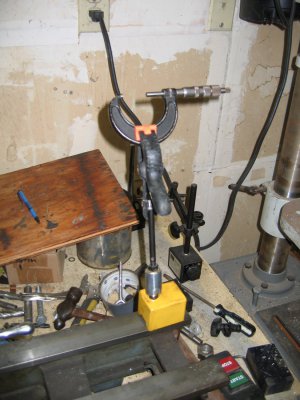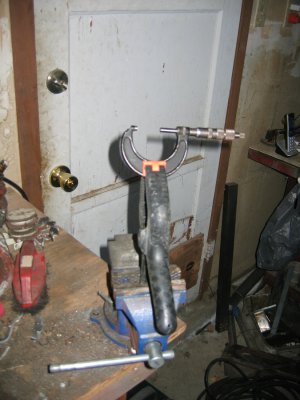I recently fitted two bronze bushings into a the apron of a lathe. The openings are where the feed rod passes through the apron to drive the worm gear. Mine have a lot of wear. I used my milling machine to bore the holes, because I don't have a second lathe. Setting the gauge by levering it through the hole seems give me fairly repeatable results. However, I'm unable to find guidance on how the gauge is read with a micrometer.
One process that seemed to make sense was to find the minimum micrometer setting that would allow the set gauge to pass through its anvils with just a hint of drag. I used this on my first attempt, and the result was the bushing fit, but required a lot of force to drive completely home.
On my second attempt, I rotated the set gauge between the micrometer anvils and chose a micrometer setting that allowed the gauge to pass freely when in line with the anvils, but I could catch a tiny bit of drag if the gauge was rotated (like rolling a pencil) just right. This time the bushing went home with what seemed like a more reasonable amount of force. It also seems to mimic the motion used to set the gauge inside the bore.
For both bushings, which were quite thin walled, the inside diameter of the bushed hole collapsed by a tiny amount and I had to enlarge the hole to get it over the drive rod. The tighter fitting one required more material to be removed, of course.
Can anyone confirm that a telescoping gauge should be read as I've possibly re-discovered? I wouldn't rule out that I just got lucky that either one fit. This was my first attempt to fit a bronze bushing. It would be nice to confirm I'm using proper technique vs. being lucky.
One process that seemed to make sense was to find the minimum micrometer setting that would allow the set gauge to pass through its anvils with just a hint of drag. I used this on my first attempt, and the result was the bushing fit, but required a lot of force to drive completely home.
On my second attempt, I rotated the set gauge between the micrometer anvils and chose a micrometer setting that allowed the gauge to pass freely when in line with the anvils, but I could catch a tiny bit of drag if the gauge was rotated (like rolling a pencil) just right. This time the bushing went home with what seemed like a more reasonable amount of force. It also seems to mimic the motion used to set the gauge inside the bore.
For both bushings, which were quite thin walled, the inside diameter of the bushed hole collapsed by a tiny amount and I had to enlarge the hole to get it over the drive rod. The tighter fitting one required more material to be removed, of course.
Can anyone confirm that a telescoping gauge should be read as I've possibly re-discovered? I wouldn't rule out that I just got lucky that either one fit. This was my first attempt to fit a bronze bushing. It would be nice to confirm I'm using proper technique vs. being lucky.



